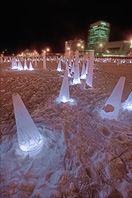News
Carter in the deep ‘Freeze’
-
 Print
Print -
 Comments
Comments

Photo: ©2009 Hal Gage, freezeproject.org
In the installation “Ice Fracture,” ice cones light up as passersby trigger motion sensors.
Related links
Anchorage, Alaska, is a long way from Buffalo, N.Y.
But a connection to Anchorage’s art museum led to Brian Carter, dean of the School of Architecture and Planning, taking on an organizational role in Freeze, Anchorage’s celebration of life in the Arctic that includes a series of outdoor installations by artists, architects and designers.
Carter worked to put together the teams of established and emerging architects and artists that created the installations, as well as chaired a public presentation of the installations that drew an audience of more than 200.
He says his involvement with Freeze actually began five or six years ago when he was a member of a panel that selected world-renowned architect David Chipperfield to design a major expansion of the Anchorage Museum at Rasmuson Center. The museum, a major sponsor of Freeze, invited Carter to participate in the winter festival, which also celebrates the museum expansion.
Freeze, which opened Jan. 10 and runs through Feb. 6, features conferences, performances and exhibitions, as well as the 14 major installations built on the city’s Delaney Park Strip that “highlight the northern elements of snow, ice and light.”
Among the installations are “Masque,” featuring glowing human heads of ice, and “Ice Fracture,” in which ice cones light up as passersby trigger motion sensors. There also are snowballs embedded with LED lights that glow from within and a 30-foot-in-diameter frozen lake full of cars over which visitors can walk and skate.
Carter calls Freeze “an amazing project” that attracted participants from such places as Iceland, Europe and Canada. He notes that Anchorage earlier this month was in the throes of its coldest snap of weather in many years, yet people were out building the installations and hundreds of visitors attended the Jan. 10 opening.
Julie Decker, project director for Freeze and a trustee of the Alaska Design Forum, another Freeze sponsor, says she conceived of the idea for Freeze after taking a trip to Scandinavia, “where it really struck me how people there celebrate their northernness. I wanted to find some way to celebrate what is unique about Alaska and to have it occur at a time when winter, darkness and cold were at their peak—so we could play with our resistance to those things,” she says.
Any lessons for Buffalo and Western New York?
“I think that there are lots of lessons,” Carter says, “lessons about the siting of buildings, lessons about the potential of materials and lessons about the value of good design. The event was also a super celebration of design and a demonstration of the impact of good public art programs on perceptions of a city.”
Decker says there are plans for a book about Freeze that would include photographs, information about the participating artists and firms, and essays. Carter would be a contributor, she adds.

Reader Comments